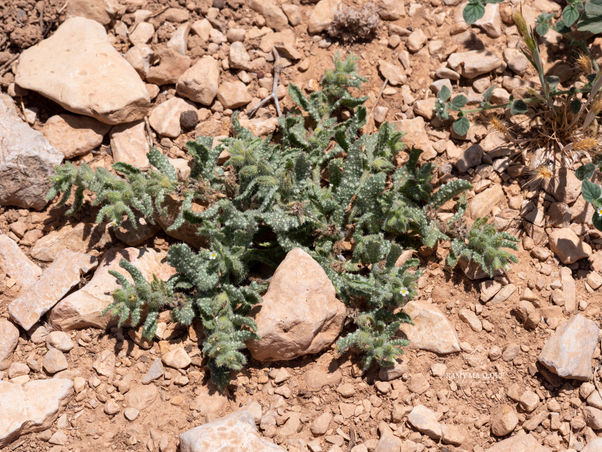Family |
Boraginaceae
Anchusa aegyptiaca
(L.) A.DC.
Anchusa aegyptiaca (L.) A.DC.
≡ Lycopsis aegyptiaca L.
(Prodr. 10: 48, 1846; Nouvelle Flore du Liban et de la Syrie, vol. 3, p. 401; Pl. XL nº 1; 1983)
• Life-form & habit: Pale-green annual, with prostrate to ascending stems, 10–40 cm long, covered with short bristly hairs borne on whitish tubercles, harsh to the touch.
• Leaves: Lower leaves obtuse, upper ones acute, somewhat bullate, margins entire or faintly crenulate-dentate.
• Inflorescence & flowers: Cymes leafy, very lax. Pedicels axillary, equal to or longer than the calyx, very accrescent, often recurved at fruiting. Calyx 5-partite; lobes lanceolate, elongated in fruit, papillose and rough to the touch, much exceeding the nutlets. Corolla pale sulphur-yellow, with tube shorter than the calyx; scales exserted, velvety.
• Fruit: Nutlets thick, semi-ovoid, straight, flat inside, convex and irregularly reticulate outside, acute at apex, rugose toward the basal ring.
• Phenology: Flowers February–April.
• Habitat & elevation: Rocky ground and sandy places.
• Lebanese distribution: Saïda (Rmeilé), Hazmiyé, Nahr Damour, Ibl-es-Saki, Kafr Matta.
• Syrian distribution: Souq Ouadi Barada, Mount Qasyoun, Douma; Chahba, Qanaouat; ruins of Palmyra; Jabal Abiad.
• Native range: Cyprus, East Aegean Islands, Egypt, Greece, Gulf States, Iran, Iraq, Kriti, Lebanon, Syria, Libya, Palestine, Saudi Arabia, Sicilia, Sinai, Tunisia, Turkey (POWO).






